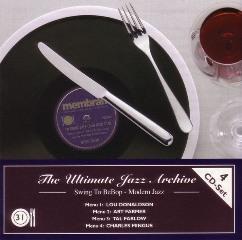The Ultimate Jazz Archive Vol.124 – Charles Mingus [1954] [2005]
The Ultimate Jazz Archive Vol.124 – Charles Mingus [1954] [2005]

01.What Is This Thing Called Love 02.Spur of the Moment 03.Thrice Upon A Theme 04.Four Hands 05.Minor Intrusions
Charles Mingus’ music is imbued with emotion. Prone to manic bursts of creativity and crushing depression, and known for his explosive temper, the virtuoso jazz bassist and composer expressed his anger, glee, sorrow, and anxiety in his compositions. Rising to fame playing bebop, Mingus went on to create a unique sound that often blended gospel, free jazz, and sometimes classical music.
Born in Arizona in 1922, Charles Mingus was raised in Watts, California. There he absorbed the gospel music of his church, and was introduced to classical music through his older sisters. He began playing the trombone, but traded it for a cello. His success on that instrument transferred easily to the bass, which he took up in high school. Also, after hearing Duke Ellington on the radio, he developed a passion for jazz. While still in school, Mingus began playing jazz professionally in Los Angeles. He then worked his way into Louis Armstrong’s band, with who he toured until 1943. During a brief period when he couldn’t find work as a musician, he got a job as a postal worker. That didn’t last long, however, and in 1951, he moved permanently to New York City.
Once in the Big Apple, Mingus began playing with the stars of the day, including Charlie Parker, Dizzy Gillespie, Miles Davis, and Thelonious Monk. Mingus even joined Duke Ellington’s band briefly, but was fired for getting into an onstage fight with trombonist Juan Tizol.
Dissatisfied with record companies’ treatment of musicians, he and drummer Max Roach formed Debut Records. The label didn’t last long, but in 1953 it managed to release a live performance at Toronto’s Massey Hall. The album, Jazz at Massey Hall, featured Mingus, Roach, Parker, Gillespie, and pianist Bud Powell. It is now regarded as one of the best documents of bebop, despite the fact that for its entirety, Mingus overdubbed himself to mask what he considered a poorly recorded bass.
In 1955 Mingus put together his own rotating ensemble, which he dubbed the “Charles Mingus Jazz Workshop.” With this group, he experimented with numerous compositional approaches, sometimes encouraging members to improvise collectively, a technique he picked up from saxophonist Ornette Coleman’s free jazz. He also used the group to voice his political frustrations, recording songs like “Fables of Faubus,” which protested the government’s mishandling of the Little Rock 9 incident, and “Don’t Let Them Drop That Atomic Bomb on Me.”
Throughout the mid 1950s and early 60s, Mingus’ composing matured, and he made some of the recordings that are currently viewed as ingenious, as well as important steps in jazz. In 1956 he released Pithecanthropus Erectus (Atlantic), an intricate composition that incorporated free jazz.
1959 brought Mingus Ah Um, which featured songs rooted in traditional jazz and gospel, as well as two beautiful ballads. One, “Goodbye Porkpie Hat,” is a tribute to saxophonist Lester Young. The other, “Self-Portrait in Three Colors,” was originally written for Shadows, a movie by director John Cassavetes, although it never made the film. In 1963, he released The Black Saint and the Sinner Lady (Impulse!), which features extended forms and brilliant orchestration.
In the 1970s, Mingus was diagnosed with amyotrophic lateral sclerosis, a muscle disease commonly known as Lou Gehrig’s disease. His playing suffered greatly, and soon he was unable to perform. He died in 1979 in Mexico at age 56. Years after his death, his final piece, an extended composition entitled “Epitath,” was discovered. In 1989, it was premiered with a 30-piece orchestra for the first time. --- Jacob Teichroew, jazz.about.com
download: uploaded anonfiles gett yandex 4shared solidfiles mediafire mega filecloudio








